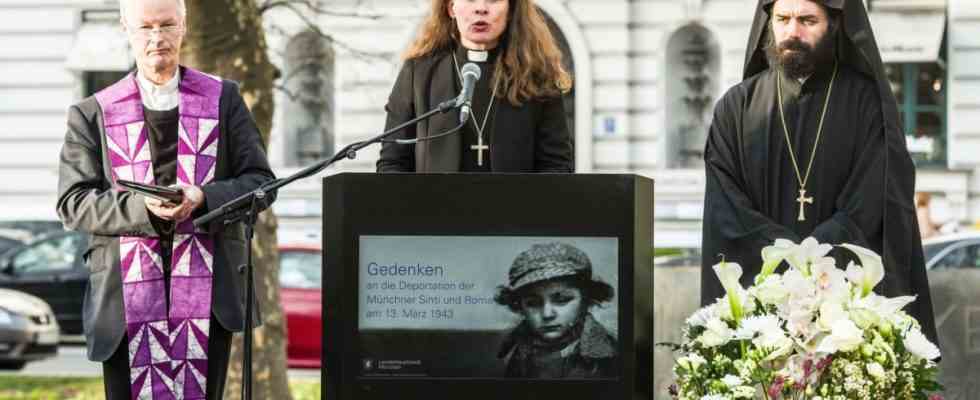For example Rosa Mettbach. She was deported from Munich to the Auschwitz concentration camp in 1944. During the transport she was guarded by a man who belonged to the Sturmabteilung (SA) of the National Socialist German Workers’ Party (NSDAP), was a civil servant and did his duty in the so-called “gypsy control center” in the police station on Ettstrasse: August Wutz.
Rosa Mettbach then experienced terrible torture in several Nazi camps, but she survived the deportation – the only one in her large family. In 1947 she applied for compensation in Munich. This was rejected in 1954. When she complained, an expert appointed by the Bavarian State Compensation Office appeared in court, who stated that Mettbach had not been brought to the camp for racist reasons, but “because of fortune-telling and antisocial behavior”: This was also the verdict of the court, with which this refused compensation “for damage to body and health and damage to economic advancement”, even compensation for imprisonment was refused. The name of the expert: August Wutz, at that time again an official at the State Criminal Police Office.
A story that tells a lot of history. Romani Rose presented them on Monday evening in the ballroom of the old town hall at the ceremony commemorating the kidnapping of 141 people exactly 80 years ago. On March 13, 1944, 141 members of the Sinti and Roma were taken from Munich to the Auschwitz-Birkenau extermination camp: women, men and many children. The youngest of the Munich deportees was six months old. “We cannot begin to imagine the immeasurable suffering of mothers and fathers, who were close to death themselves and still had to watch helplessly as their own children starved to death,” said Mayor Katrin Habenschaden (Greens) at the ceremony. Because their forearms were too thin, the babies got their concentration camp prisoner numbers tattooed on their thighs. They started with a Z.Z for “Gypsy”. With this stigma, members of the minority were excluded.
To this day, it is only possible to estimate how many of them perished in the killing factories: the Central Council of German Sinti and Roma estimates that there were up to 500,000 in all of Europe. The Nazis’ obsession with destruction was bureaucratically organized – the departure and arrival times of the concentration camp trains, in which people were crammed together in overcrowded freight cars for days without eating or drinking, were set to the minute: “Arrival Auschwitz 15:01.” And the torment was rampant, as eyewitness documents made it possible to experience the cultural advisor Anton Biebl, FC Bayern President Herbert Hainer, writer Lena Gorelik, director Caroline Link and the victims’ relatives Hugo and Marco Höllenreiner, moderated by Mirjam Zadoff, the head of the NS -Documentation Center, lectured.
It wasn’t just mass murder. It was genocide. And the survivors were also marked. About mistreatment, about experiments, about sterilizations that were even carried out on children. And when the war ended, the stigma by no means went away.
What was special about the persecution of the Sinti and Roma: the police were particularly involved. Also in Munich. As early as 1899, a so-called “Gypsy Center” was set up here, which was soon regarded as groundbreaking throughout the country. On March 8, 1943, according to a decree by Interior Minister Heinrich Himmler, the officials marched, as elsewhere in the country, to surround the houses of the Sinti and Roma and bring the members of this population group to prison. In Munich, this was the police prison on Ettstrasse. Five days later, the deportation trains set off from the freight depot.
After the war, there were quickly again “country driver centers” and even after they were dissolved in the 1960s, “special registrations” continued for some time. The fact that Sinti and Roma had been killed for racial reasons, as it was called in Nazi jargon, receded into the background and the motive of alleged “crime prevention” became firmly established. “The perpetrators – the murderers and accomplices – have determined the view of Sinti and Roma with the narrative to this day,” said Mehmet Daimaguler, the federal government’s commissioner against antiziganism, on Monday in the old town hall – and he sounded so angry as appropriate for the occasion. The fact that Munich’s chief of police, Thomas Hampel, was present was praised more than once.
The names and biographical data of the 141 deportees had previously been read out at the Place of Victims of National Socialism, after which they were projected for three hours onto the facade of the NS Documentation Center. Visible reminder that commemoration begins with remembering, but does not end.
Despite the humiliation, Rosa Mettbach continued to fight for compensation for her fateful time in the camp. In 1967 she was awarded DM 1,500 for this, around EUR 750. She went to the Federal Court of Justice. But it was not until 1987 that she received an additional payment of DM 3,500 and a monthly transfer of DM 515. That was the minimum compensation pension at the time.

